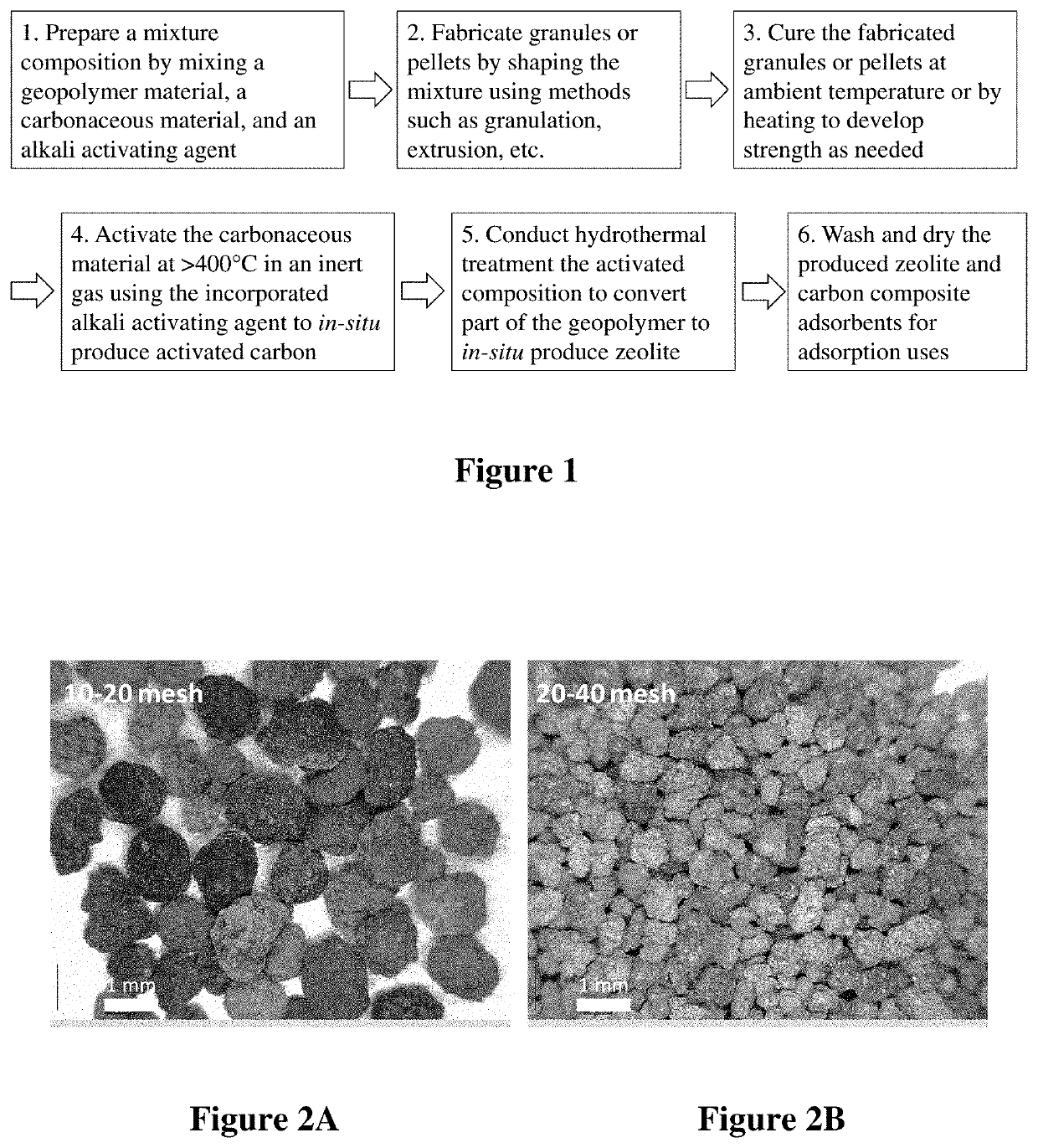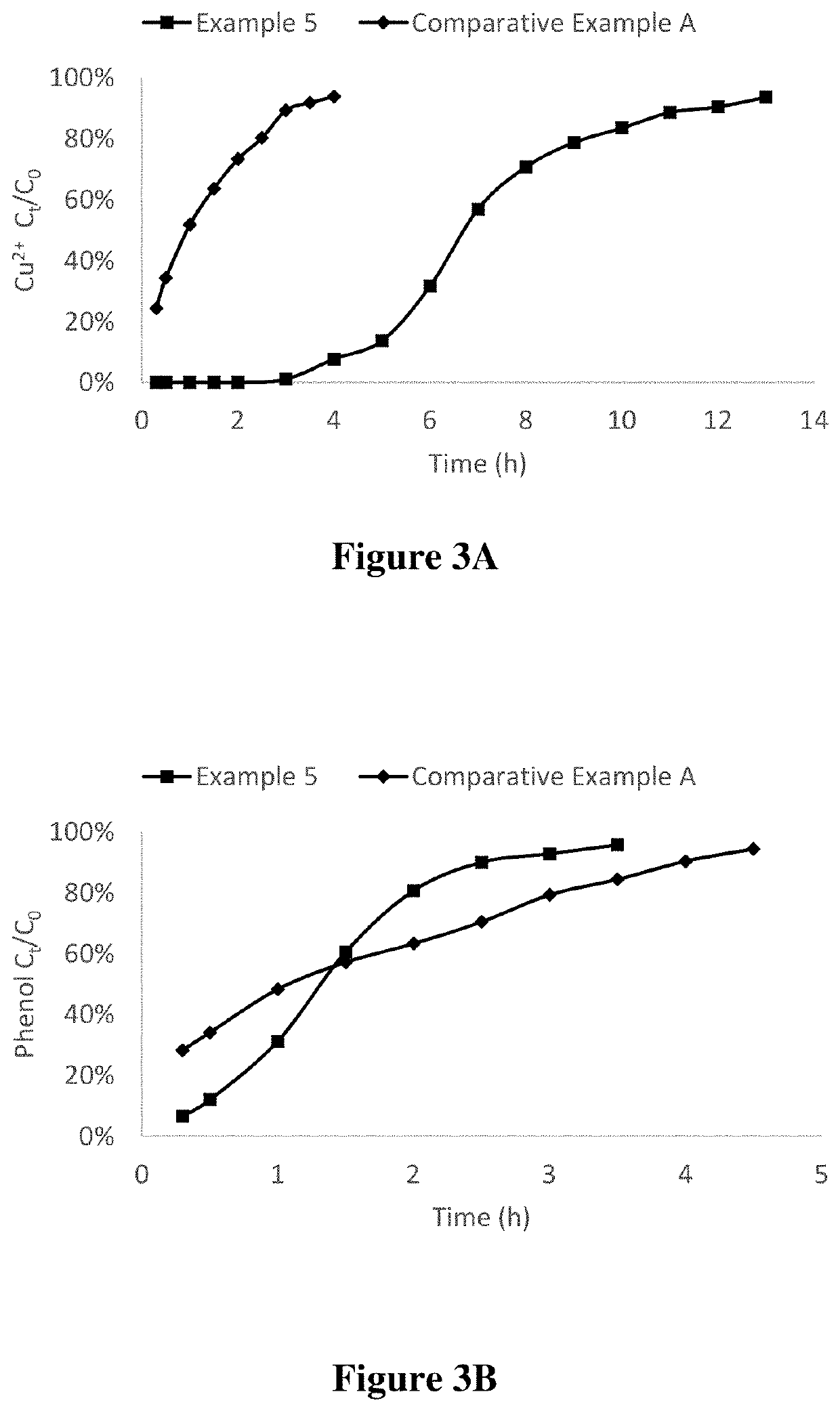Composite adsorbents and method of making them
a technology of composite adsorbents and adsorbents, which is applied in cement production, other chemical processes, chemistry apparatus and processes, etc., can solve the problems of less effective adsorption of inorganic pollutants, large size organic molecules, and less effective adsorption of activated carbon, so as to achieve versatile and effective adsorption, effective removal of both inorganic pollutants and effective adsorption
- Summary
- Abstract
- Description
- Claims
- Application Information
AI Technical Summary
Benefits of technology
Problems solved by technology
Method used
Image
Examples
example 1
[0061]A composite mixture composition is prepared by mixing and aging wood sawdust with a sodium hydroxide activating agent solution at ambient temperature for overnight, mixing metakaolin with a sodium silicate activator solution to prepare a geopolymer composition, and then mixing the above two mixtures right after the geopolymer preparation to produce a uniform paste mixture. The composite mixture comprises by weight 22 wt % of metakaolin, 13 wt % of sodium silicate solution, 22 wt % of dry wood sawdust, and 43 wt % of sodium hydroxide activating agent solution. The alkali activating agent (sodium hydroxide solid) to carbonaceous material (wood sawdust) solid mass ratio is 1:1.
[0062]The prepared composite paste mixture is ground in a coffee grinder and then tumbled in a rotating tumbler to shape the mixture and form green granules. The green granules are placed into a sealed container and heated at 60° C. to cure the geopolymer composition and further treat the wood material in t...
example 2
[0066]A composite mixture composition is prepared by mixing and aging wood sawdust with a sodium hydroxide activating agent solution at 60° C. for overnight, mixing metakaolin with a sodium silicate activator solution to prepare a geopolymer composition, and then mixing the above two mixtures right after the geopolymer preparation to produce a uniform paste mixture. The composite mixture comprises by weight 15 wt % of metakaolin, 9 wt % of sodium silicate solution, 22 wt % of dry wood sawdust, and 54 wt % of sodium hydroxide activating agent solution. The alkali activating agent (sodium hydroxide solid) to carbonaceous material (wood sawdust) solid mass ratio is 1.2:1.
[0067]The prepared composite paste mixture is processed using the same shaping, alkali activation, and hydrothermal process as that in Example 1. XRD analysis of the fabricated composite adsorbents shows that zeolites NaX and NaA are formed in the composite material with NaX as the major phase. The inorganic and organi...
example 3
[0068]A composite mixture composition is prepared by mixing wood sawdust with a sodium hydroxide activating agent solution, mixing metakaolin with a sodium silicate activator solution to prepare a geopolymer composition, and then mixing the above two mixtures right after the geopolymer preparation to produce a uniform paste mixture. The composite mixture comprises by weight 27 wt % of metakaolin, 16 wt % of sodium silicate solution, 14 wt % of dry wood sawdust, and 43 wt % of sodium hydroxide activating agent solution. The alkali activating agent (sodium hydroxide solid) to carbonaceous material (wood sawdust) solid mass ratio is 1.5:1.
[0069]The prepared composite paste mixture is processed using the same shaping, alkali activation, and hydrothermal process as that in Example 1. XRD analysis of the fabricated composite adsorbents shows that zeolites NaX and NaA are formed in the composite material with NaX as the major phase. The inorganic and organic adsorption performance of the c...
PUM
| Property | Measurement | Unit |
|---|---|---|
| Temperature | aaaaa | aaaaa |
| Temperature | aaaaa | aaaaa |
| Temperature | aaaaa | aaaaa |
Abstract
Description
Claims
Application Information
 Login to View More
Login to View More - R&D
- Intellectual Property
- Life Sciences
- Materials
- Tech Scout
- Unparalleled Data Quality
- Higher Quality Content
- 60% Fewer Hallucinations
Browse by: Latest US Patents, China's latest patents, Technical Efficacy Thesaurus, Application Domain, Technology Topic, Popular Technical Reports.
© 2025 PatSnap. All rights reserved.Legal|Privacy policy|Modern Slavery Act Transparency Statement|Sitemap|About US| Contact US: help@patsnap.com


